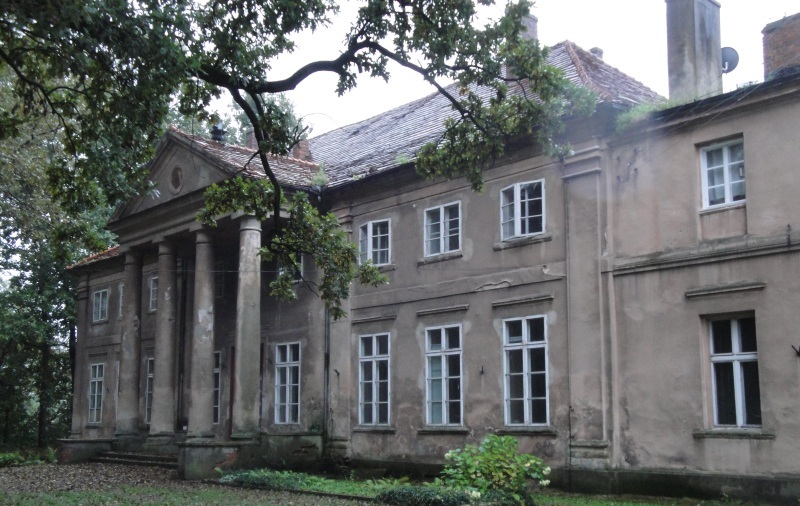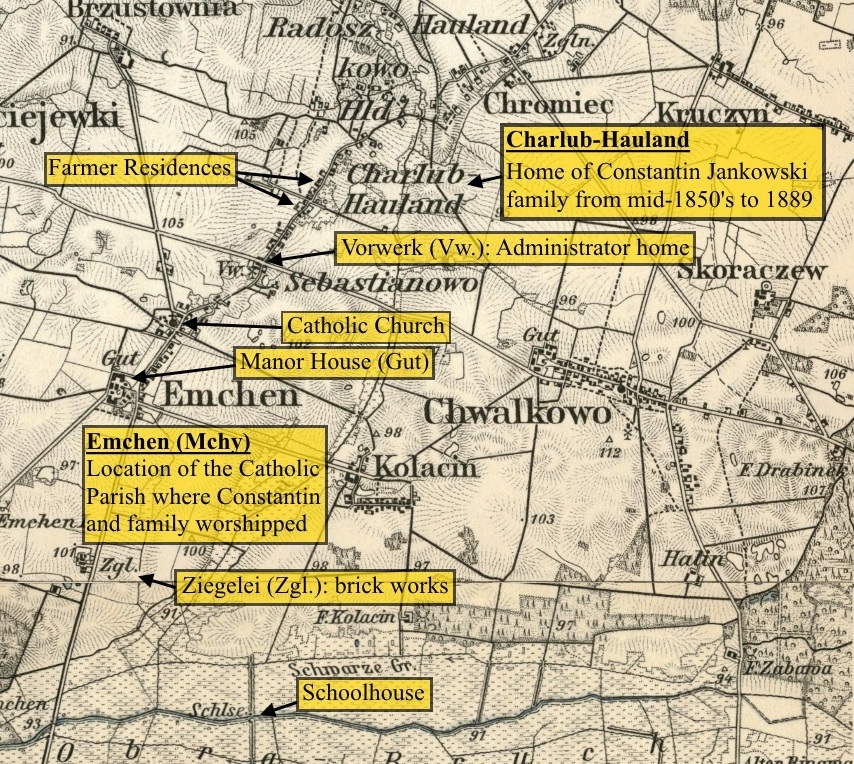Constantin Jankowski would have been employed here
A Manorial Farm usually consisted of a manor house (Gut), many large barns, and residences for the workers, all of which extended over large tracts of land and into adjacent villages owned by the manor. Within these adjacent villages, there were small scale farms which the small farmer residents had the right to pass on to their descendants. In other cases, the workers lived in the manor house or in nearby structures. Constantin Jankowski (Lena's Grandpa) and his family lived in one of the small farm residences in Charlub. He was employed by the manor owner, who resided at the manor house or "Gut", which was in Emchen (Mchy). According to family lore, Constantin's job was to tend the horses for the manor. Here is a picture of the Gut in Emchen:

This photo was taken in 2010. The Gut appeared to be vacant, and had fallen into a state of disrepair. I don't know if this structure was standing when Constantin was employed here, but it appears as though it was originally a brick structure, which was subsequently stuccoed over. In all likelihood, this Gut was standing at the time, although possibly without the stucco. This would have been an impressive and imposing building for its time and location. This is likely due to the fact that generally the manor owner was part of a noble family.
The map below depicts the Manorial Farm in Mchy, including the surrounding villages with small-farmer residences:

As stated, the land held by the noble family was often very large and spread out. On the map, you can see the location of the Gut in Emchen. This was the home of the manor owner. The "Vw" in Sebastiano is an abbreviation for the German word, Vorwerk, which would be like a Supervisor in an outlying area from the Manor House. He would've most likely been the person who Constantin would have interacted with on a daily basis. Also on the map, you can see the small-farmer residences along the main road out of Emchen and through Charlub. Constantin would have lived in one of these residences. Because the estate was so large, many barns were required to house the equipment and produce of the land. These are indicated by the larger structures on the map.
Here are a couple photos showing a residence and barn in Charlub:
The left photo shows a small-farmer residence (right side of the photo) with a small barn in back. Most likely the barn would have belonged to the Manor. The right photo shows a larger barn with a small-farmer residence behind. Both of these structures are in Charlub. I don't know if they existed during Constantin's era. My guess is that the red brick was manufactured in the brickworks south of Emchen (see map). If so, then most likely these structures could have been built during Constantin's day.
The manorial farm had three kinds of workers:The small farmer had a house, outbuildings, land for a small garden, and land for cash crops such as rye, barley, or oats in the old days and potatoes after 1750. The small farmer would pay his rent in grain and in unpaid work on the manorial farm (often 3 days a week). Given that the Prussian plow used during this period was very heavy and hard to turn around, the land outside the village was subdivided into long strips several furrows wide, each associated with a small farmer.
- The small resident farmer who had hereditary tenure on the estate land
- Farm servants who worked an annual contract
- Day Laborers, as well as supporting people like millers and tavern keepers
A manorial farm typically had upwards of 20 farm servants doing tasks liking cooking, herding, working in the dairy, and being a crew foreman. The farm servants were usually hired on an annual contract after their confirmation. The lord of the manor could require compulsory service from the children of the small farmers for up to three years. This type of work provided a good bridge between childhood and marriage, particularly for non-inheriting children. These workers received food, clothing, housing, and a small amount of money.
There were also day laborers on the manorial estate. These were usually people without inheritance rights and who would be otherwise impoverished. They often roomed and boarded with a small farmer providing a supplemental income source to the small farmer. They would receive some pay for work but also had unpaid commitments to the estate; they were particularly valuable at harvest time. If these people had no source of income, the local church had to provide support for them.
To be successful, the farmer needed a capable wife to share the tasks. The marriages were not based on good looks and romantic love but would be best thought of as a business partnership. The financial package included gaining inheritance rights, a woman's dowry, gifts from both families, rights for the man's parents to retire and live in an outbuilding on the land, and payments to disenfranchised siblings. Divorce was virtually unknown.
The eldest male of resulting children typically inherited the property rights upon his marriage and the other children would receive some financial buyout. This event occurred after confirmation at 13 or 14 but often before 20 if there was inheritable farm. There were variations on this inheritance arrangement when there were no male children or the children were quite young.
It is clear then, that the non-inheriting children of the small farmers as well as the day laborers often had to move elsewhere in search of land to farm. As Constantin was not the eldest male of his family (he had an older brother Francis), this would most likely be the reason for his move from Czarkowo to Charlub. A generation later, Constantin's eldest male(s) were twins - Michael and Stanislaus. I don't know how the inheritance would have worked in such a case, nor do I know which of the two were the inheriting son. My guess would be that Stanislaus inherited the property based on the fact that Michael left Poland first while Stanislaus remained in Poland until immigrating with his parents to the USA.
There were a number of special functionaries also associated with the estate. There were millers who ground grains into flour and other products. Millers often purchased this right from the lord of the manor, plus they paid an annual fee in grain. Tavern keepers (krugers) purchased or leased the right to brew and to run an inn; additionally the kruger might pay fees in beer or money. Both millers and krugers often had land for growing food for their own consumption.
The lord of the manor had the right to be judge for minor infractions committed by people on his estate. This was often done indirectly by appointing a judge. The parameters of justice were fairly well defined and limited by the Prussian government, as earlier there had been abuses of the system. Often the villages had village heads (schultz). Schultz were powerful in villages of free farmers or where the schultz privilege was inheritable. However, in manorial villages the schultz were unpaid and disenfranchised; they were caught between the interests of the lord of the manor and those in the manorial village.
In 1807 the world of the manorial village changed. Napoleon defeated the vaunted Prussian Army and a reform minded Prussian government took over. The new government began the process of disbanding the manorial farms and dividing up the property between the manor and the farmers with hereditary rights. The time this disbanding took varied widely but in the long run the estates lost their power over the peasants, as well as much of the land.